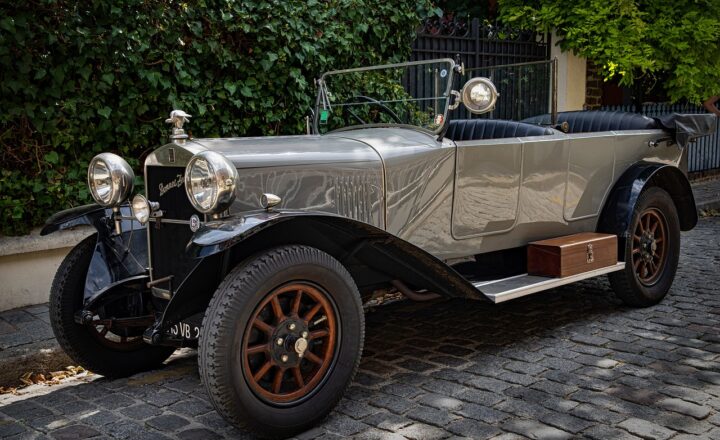Unveiling the Secrets of the World’s Most Iconic Cars: A Journey Through Automotive History
November 17, 2024

The automotive industry has chronicled a dynamic saga of innovation, freedom, and cultural evolution. Throughout the years, certain cars have transcended their utilitarian purpose, becoming icons that represent not just technological advancement but also the zeitgeist of their times. This article explores the intricate history behind some of the world’s most iconic cars, examining their cultural significance, evolutionary journey, and lasting impact on society and industry alike.
1. The Birth of the Automobile: Early Innovations
The genesis of the automobile can be traced back to the late 19th century. The first true automobile was created by Karl Benz in 1885, a modest three-wheeled vehicle powered by an internal combustion engine. This invention laid the groundwork for what would become the automotive revolution.
As curiosity turned into ambition, many inventors followed suit, building their prototypes. Among these was the French engineer, Émile Roger, who showcased a ten-horsepower gasoline-powered vehicle in Paris, which marked the first time an automobile was seen in a public setting.
The advent of the automobile tipped the scales in favor of personal transportation, and it soon became clear that this innovation would alter society in profound ways, from urban design to social mobility.
2. The Ford Model T: Revolutionizing Mass Production
In 1908, Henry Ford introduced the Model T, a vehicle that would change the automotive landscape forever. Priced affordably, this car was accessible to the masses, making car ownership a reality for everyday Americans. Ford’s innovative assembly line production method drastically reduced manufacturing time and costs, paving the way for mass production in numerous industries.
“The Model T is a symbol of the American spirit. It opened the roads to millions and brought the world closer together.”
The Model T became the backbone of American life, representing freedom and creativity. Whether used for work, errands, or leisure, it facilitated a lifestyle that had previously been unimaginable for many.
3. The Chevrolet Corvette: An American Sports Legend
No discussion about iconic cars would be complete without mentioning the Chevrolet Corvette. Introduced in 1953, the Corvette became a symbol of American power and performance. This two-seater sports car offered exhilarating speed with a sleek design, marrying aesthetics with functionality.
Over the decades, the Corvette has undergone various transformations, each model reflecting changes in design philosophy and automotive technology. Its reputation in motorsports bolstered its appeal, and it has remained a staple of the Geneva auto show since its debut.
4. The Volkswagen Beetle: A Cultural Phenomenon
The Volkswagen Beetle is renowned for its distinct shape and friendly demeanor, initially designed in the 1930s as the ‘people’s car.’ After the war, the Beetle symbolized Germany’s post-war economic recovery and has since become one of the best-selling cars in history.
Its quirky design appealed to various demographics, appealing to flower children in the 1960s and eco-conscious individuals today. The Beetle’s impact on car culture is immeasurable; it features prominently in films, music, and art, embodying the spirit of freedom and individuality.
5. The Porsche 911: A Benchmark for Performance
When it comes to performance and design, the Porsche 911 stands out as one of the most iconic cars of all time. First unveiled in 1964, the 911 has become synonymous with performance and precision engineering. It has carved a unique niche for itself in the automotive world, appealing to both track enthusiasts and luxury buyers alike.
Through its constant evolution, Porsche has kept the 911 relevant, incorporating cutting-edge technology while respecting traditional design aspects. Its versatility makes it equally at home on the racetrack and the open highway, which is a testament to its lasting appeal.
6. The Tesla Model S: Redefining Electric Vehicles
In recent years, Tesla’s Model S has pushed the boundaries of what electric vehicles can achieve. Launched in 2012, it combines luxury, performance, and sustainability, challenging the traditional automotive industry’s norms.
With an impressive range and lightning-fast acceleration, the Model S has elevated public perception of electric vehicles from an eco-friendly alternative to a viable high-performance option. Furthermore, its innovative technology features, like over-the-air software updates and autopilot capabilities, have set a new standard for the industry, encouraging other automakers to pivot in a more sustainable direction.
7. The Toyota Prius: A Step Toward Sustainability
Symbolizing a shift in societal values towards environmental consciousness, the Toyota Prius debuted in 1997 as the world’s first mass-produced hybrid vehicle. The Prius revolutionized perceptions of fuel efficiency and eco-friendliness.
As more consumers began to prioritize sustainability, the Prius met this new demand, illustrating that responsible choices could result in substantial savings and reduced carbon emissions. Its success also sparked interest in hybrid technology among other manufacturers, leading to a proliferation of eco-friendly vehicles in the years that followed.
8. Conclusion: Cars as Cultural Icons
From the designs that capture our imaginations to the engineering feats that inspire awe, iconic cars encapsulate moments in time. They are not merely machines but cultural touchstones that reflect our values, aspirations, and travels. Every iconic car tells its own story, demonstrating how the evolution of automotive technology coincides with the unfolding of human history. As we glance back at these automotive marvels, it is vital to recognize their enduring influence on society and innovation. The story of cars is not merely about transportation; it is a fascinating narrative of freedom, identity, and cultural evolution that continues to drive forward into the future.







